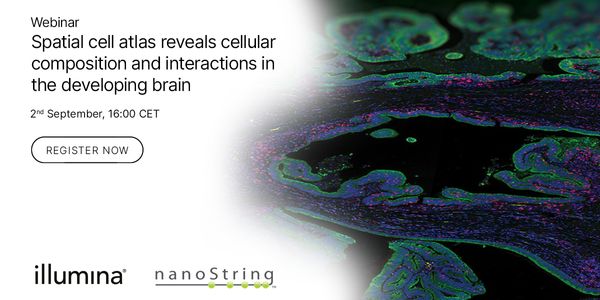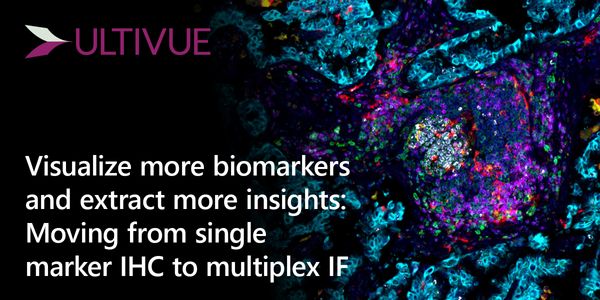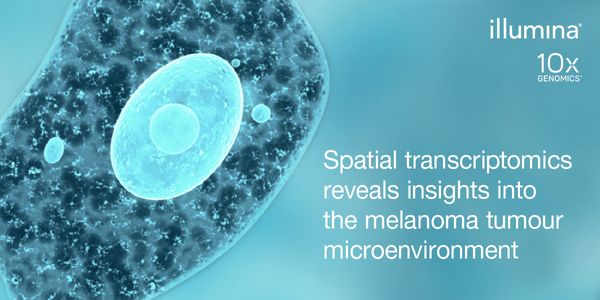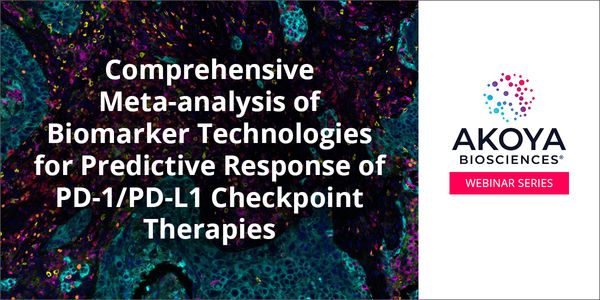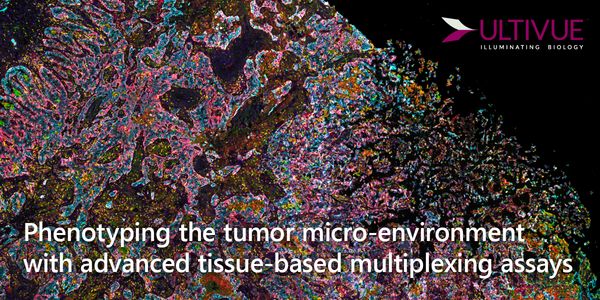Spatial Genomics
Spatial genomics utilizes a variety of methods in order to measure the gene activity within a tissue sample, subsequently allowing for the mapping of where the gene activity is occurring.
-
SEP 23, 2020 | 10:30 AMSpeaker TBD 10:30–10:50 am PDT Exploring the immune tumor microenvironment of hepatocellular carcinoma with Imaging Mass Cytometry™ 10:50 am–11:10 am PDT Presented By: Won...Speaker: Won Jin Ho, MD , Melissa B. Davis, PhDPresented at: 9th Annual Fluidigm Mass Cytometry Virtual Summit
SEP 23, 2020 | 12:00 AMI will present our new computer vision algorithm, ST-Net, which can computationally synthesize spatially resolved transcriptomics directly from H&E histology images (He et al. Nature Bio...SEP 23, 2020 | 12:00 AMGeoMx Digital Spatial Profiling Technology! The GeoMx Digital Spatial Profiler (DSP) is a novel platform developed by NanoString. This leading digital technology offers multiplexed measureme...SEP 17, 2020 | 11:00 AMIn less than nine months, the Severe Acute Respiratory Syndrome Coronavirus 2 (SARS-CoV-2) has killed hundreds of thousands of people, including >23,000 in New York City (NYC) alone. The...SEP 02, 2020 | 7:00 AMDATE: September 2, 2020 TIME: 03:00pm PDT, 6:00pm EDT Spatial omics is an expanding collection of methods to examine biological molecules in their geographical context. By retaining the prec...Speaker: Dr. Omer Bayraktar , Pawel Zajac, Ph.D. , Dr. Rudy Van EijsdenSponsored By: Illumina, NanoString TechnologiesJUN 17, 2020 | 1:30 PMUnderstanding the complex interplay between a pathogen and the host response is important to developing effective vaccines and therapeutics. The nCounter® Analysis System and GeoMx®...Speaker: Joseph M. Beechem, PhD , Christopher E. Mason, PhD , Robert Schwartz, PhDJUN 02, 2020 | 4:30 PM...Speaker: Plenary Keynote: Xiaowei Zhuang, PhDMAY 20, 2020 | 11:15 AMMetastatic prostate cancer (mPC) is a phenotypically diverse disease with poor responses to immune based therapeutics. Development of immunotherapeutic strategies for mPC is hampered by the...MAY 19, 2020 | 1:45 PMWhile many technologies focus on either exploring the spatial context of a handful of targets, or expression patterns of hundreds or thousands of targets in bulk samples or dissociated singl...MAY 19, 2020 | 1:15 PMPancreatic Ductal Adenocarcinoma (PDAC) is a highly aggressive disease associated with poor outcome. It is expected to be the leading cause of cancer-related death in 2030. The unique microe...MAY 19, 2020 | 11:45 AMPancreatic ductal adenocarcinoma (PDAC) remains a treatment-refractory disease and existing molecular subtypes do not inform clinical decisions. Previously-identified bulk transcriptomic sub...Speaker: William L. Hwang, MD, PhDPresented at: Advancing Science - A Virtual Oncology Conference
MAY 19, 2020 | 11:15 AMBackground: Growing evidence supports the critical role of preexisting immune response in triple negative breast cancer (TNBC). However, there are limitations with current evaluation approac...APR 21, 2020 | 1:30 PMTriple-negative breast cancer (TNBC) is an aggressive disease that accounts for 10-20% of all breast cancer cases diagnosed annually in the U.S.1. Despite its prevalence, TNBC remains resist...Speaker: Dina Finan, PhD , Stephen Williams, PhDPresented at: Genetics Week Virtual Event Series 2020
APR 21, 2020 | 12:00 AMSince the introduction of single cell sequencing techniques to the genomics community, interest in its use has grown exponentially and the number of single cell publications has exploded. Th...APR 16, 2020 | 9:00 AMDATE: April 16, 2020 TIME: 9:00am PT, 12:00pm ET There is an increasing need to evaluate and understand unique phenotypes and mechanisms of action within the tumor microenvironment. Existing...APR 15, 2020 | 9:00 AMDATE: April 15, 2020 TIME: 9:00am PT, 12:00pm ET We report a molecular assay, Methyl-HiC, that can simultaneously capture the chromosome conformation and DNA methylome in a cell. Methyl-HiC...SEP 26, 2019 | 1:30 PMRNA-Seq has been used for the past decade to gain significant insights into gene expression. Using bulk methods however only allow for an understanding of the average gene expression within a...SEP 26, 2019 | 10:30 AMThe ability to discern spatial gene expression differences in complex biological systems is critical to our understanding of developmental biology and the progression of disease. However, the...SEP 26, 2019 | 9:00 AMEarly detection is critical for improved survival in melanoma. Melanocytic nevi are extremely common benign tumors that mimic melanoma and are therefore commonly biopsied. Currently, the dete...Speaker: Margaret Hoang, PhD , Maija Kiuru, PhDPresented at: Cell Biology Virtual Event Series 2019
SEP 17, 2019 | 9:00 AMDATE: September 17, 2019TIME: 9:00am PTSpatial Transcriptomics (ST) technology reveals gene expression from up to one thousand spots across a tissue section. In this webinar, Dr. H...Speaker: Hanna Eriksson, M.D., PhD , Kim Thrane , Dr. Aida Soler , Dr. Stephen HagueAUG 27, 2019 | 9:00 AMDATE: August 27, 2019 TIME: 9:00am PDT, 12:00pm EDT Immunotherapies targeting PD-1 or PD-L1 have proven remarkably effective for treating cancer in some patients, with considerabl...JUN 20, 2019 | 1:30 PMTumor heterogeneity is a hallmark of cancer and can have significant impact on identifying drivers, including those that may be therapeutically relevant. Although, the traditional sequencing...JUN 20, 2019 | 6:00 AMVirtually all tumors are genetically heterogeneous, containing subclonal populations of cells that are defined by distinct mutations. Subclones can have unique phenotypes that influence disea...MAR 21, 2019 | 7:00 AMDATE: March 21, 2019TIME: 7:00am PDT, 10:00am EDT The benefits of multiplex immunohistochemistry assays for tissue analysis are numerous. High-level multipl...
SEP 23, 2020 | 10:30 AM
Speaker TBD 10:30–10:50 am PDT Exploring the immune tumor microenvironment of hepatocellular carcinoma with Imaging Mass Cytometry™ 10:50 am–11:10 am PDT Presented By: Won...
Speaker:
Won Jin Ho, MD
, Melissa B. Davis, PhD
Presented at: 9th Annual Fluidigm Mass Cytometry Virtual Summit
SEP 23, 2020 | 12:00 AM
I will present our new computer vision algorithm, ST-Net, which can computationally synthesize spatially resolved transcriptomics directly from H&E histology images (He et al. Nature Bio...
SEP 23, 2020 | 12:00 AM
GeoMx Digital Spatial Profiling Technology! The GeoMx Digital Spatial Profiler (DSP) is a novel platform developed by NanoString. This leading digital technology offers multiplexed measureme...
SEP 17, 2020 | 11:00 AM
In less than nine months, the Severe Acute Respiratory Syndrome Coronavirus 2 (SARS-CoV-2) has killed hundreds of thousands of people, including >23,000 in New York City (NYC) alone. The...
SEP 02, 2020 | 7:00 AM
DATE: September 2, 2020 TIME: 03:00pm PDT, 6:00pm EDT Spatial omics is an expanding collection of methods to examine biological molecules in their geographical context. By retaining the prec...
Speaker:
Dr. Omer Bayraktar
, Pawel Zajac, Ph.D.
, Dr. Rudy Van Eijsden
Sponsored By: Illumina,
NanoString Technologies
JUN 17, 2020 | 1:30 PM
Understanding the complex interplay between a pathogen and the host response is important to developing effective vaccines and therapeutics. The nCounter® Analysis System and GeoMx®...
Speaker:
Joseph M. Beechem, PhD
, Christopher E. Mason, PhD
, Robert Schwartz, PhD
JUN 02, 2020 | 4:30 PM
...
Speaker:
Plenary Keynote: Xiaowei Zhuang, PhD
MAY 20, 2020 | 11:15 AM
Metastatic prostate cancer (mPC) is a phenotypically diverse disease with poor responses to immune based therapeutics. Development of immunotherapeutic strategies for mPC is hampered by the...
MAY 19, 2020 | 1:45 PM
While many technologies focus on either exploring the spatial context of a handful of targets, or expression patterns of hundreds or thousands of targets in bulk samples or dissociated singl...
MAY 19, 2020 | 1:15 PM
Pancreatic Ductal Adenocarcinoma (PDAC) is a highly aggressive disease associated with poor outcome. It is expected to be the leading cause of cancer-related death in 2030. The unique microe...
MAY 19, 2020 | 11:45 AM
Pancreatic ductal adenocarcinoma (PDAC) remains a treatment-refractory disease and existing molecular subtypes do not inform clinical decisions. Previously-identified bulk transcriptomic sub...
Speaker:
William L. Hwang, MD, PhD
Presented at: Advancing Science - A Virtual Oncology Conference
MAY 19, 2020 | 11:15 AM
Background: Growing evidence supports the critical role of preexisting immune response in triple negative breast cancer (TNBC). However, there are limitations with current evaluation approac...
APR 21, 2020 | 1:30 PM
Triple-negative breast cancer (TNBC) is an aggressive disease that accounts for 10-20% of all breast cancer cases diagnosed annually in the U.S.1. Despite its prevalence, TNBC remains resist...
Speaker:
Dina Finan, PhD
, Stephen Williams, PhD
Presented at: Genetics Week Virtual Event Series 2020
APR 21, 2020 | 12:00 AM
Since the introduction of single cell sequencing techniques to the genomics community, interest in its use has grown exponentially and the number of single cell publications has exploded. Th...
APR 16, 2020 | 9:00 AM
DATE: April 16, 2020 TIME: 9:00am PT, 12:00pm ET There is an increasing need to evaluate and understand unique phenotypes and mechanisms of action within the tumor microenvironment. Existing...
APR 15, 2020 | 9:00 AM
DATE: April 15, 2020 TIME: 9:00am PT, 12:00pm ET We report a molecular assay, Methyl-HiC, that can simultaneously capture the chromosome conformation and DNA methylome in a cell. Methyl-HiC...
SEP 26, 2019 | 1:30 PM
RNA-Seq has been used for the past decade to gain significant insights into gene expression. Using bulk methods however only allow for an understanding of the average gene expression within a...
SEP 26, 2019 | 10:30 AM
The ability to discern spatial gene expression differences in complex biological systems is critical to our understanding of developmental biology and the progression of disease. However, the...
SEP 26, 2019 | 9:00 AM
Early detection is critical for improved survival in melanoma. Melanocytic nevi are extremely common benign tumors that mimic melanoma and are therefore commonly biopsied. Currently, the dete...
Speaker:
Margaret Hoang, PhD
, Maija Kiuru, PhD
Presented at: Cell Biology Virtual Event Series 2019
SEP 17, 2019 | 9:00 AM
DATE: September 17, 2019TIME: 9:00am PTSpatial Transcriptomics (ST) technology reveals gene expression from up to one thousand spots across a tissue section. In this webinar, Dr. H...
Speaker:
Hanna Eriksson, M.D., PhD
, Kim Thrane
, Dr. Aida Soler
, Dr. Stephen Hague
AUG 27, 2019 | 9:00 AM
DATE: August 27, 2019 TIME: 9:00am PDT, 12:00pm EDT Immunotherapies targeting PD-1 or PD-L1 have proven remarkably effective for treating cancer in some patients, with considerabl...
JUN 20, 2019 | 1:30 PM
Tumor heterogeneity is a hallmark of cancer and can have significant impact on identifying drivers, including those that may be therapeutically relevant. Although, the traditional sequencing...
JUN 20, 2019 | 6:00 AM
Virtually all tumors are genetically heterogeneous, containing subclonal populations of cells that are defined by distinct mutations. Subclones can have unique phenotypes that influence disea...
MAR 21, 2019 | 7:00 AM
DATE: March 21, 2019TIME: 7:00am PDT, 10:00am EDT The benefits of multiplex immunohistochemistry assays for tissue analysis are numerous. High-level multipl...





